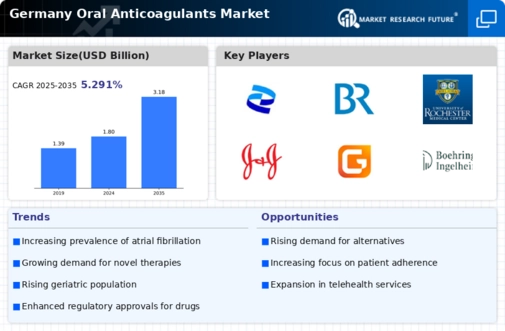Advancements in Drug Formulations
Innovations in drug formulations are playing a crucial role in shaping the oral anticoagulants market. Recent developments have led to the introduction of novel anticoagulants that offer improved safety profiles and dosing convenience. For instance, the emergence of once-daily dosing regimens has enhanced patient adherence, which is vital for effective anticoagulation therapy. Additionally, the development of reversal agents for direct oral anticoagulants has further bolstered confidence among healthcare providers in prescribing these medications. The German pharmaceutical industry is actively investing in research and development to create more effective and safer anticoagulant options. This focus on innovation is expected to stimulate market growth, as healthcare professionals increasingly prefer newer formulations that align with contemporary treatment protocols.
Technological Integration in Healthcare
The integration of technology in healthcare is emerging as a significant driver for the oral anticoagulants market. Digital health solutions, including telemedicine and mobile health applications, are enhancing patient management and monitoring. These technologies facilitate better communication between patients and healthcare providers, allowing for timely adjustments in anticoagulation therapy. In Germany, the adoption of electronic health records (EHR) is streamlining the management of patients on anticoagulants, ensuring that healthcare professionals have access to comprehensive patient data. This technological advancement not only improves patient outcomes but also encourages adherence to treatment protocols. As technology continues to evolve, its impact on the oral anticoagulants market is expected to grow, fostering a more efficient healthcare delivery system.
Growing Awareness and Education Initiatives
Increasing awareness and education initiatives regarding the risks of thromboembolic events are driving the oral anticoagulants market in Germany. Healthcare organizations and patient advocacy groups are actively promoting education on the importance of anticoagulation therapy for at-risk populations. Campaigns aimed at educating both healthcare professionals and patients about the benefits and risks associated with anticoagulant use are becoming more prevalent. This heightened awareness is likely to lead to earlier diagnosis and treatment of conditions requiring anticoagulation, thereby expanding the patient base. Furthermore, as patients become more informed about their treatment options, they may be more inclined to adhere to prescribed therapies, positively impacting the oral anticoagulants market.
Regulatory Support and Reimbursement Policies
Supportive regulatory frameworks and favorable reimbursement policies are significant drivers of the oral anticoagulants market in Germany. The German healthcare system, characterized by its robust insurance coverage, facilitates access to essential medications, including oral anticoagulants. The Federal Joint Committee (G-BA) plays a pivotal role in determining the reimbursement status of new anticoagulant therapies, which can significantly influence market dynamics. Recent policy changes have expanded coverage for innovative anticoagulants, making them more accessible to patients. This regulatory support not only encourages the adoption of new therapies but also enhances the overall market landscape. As reimbursement policies continue to evolve, they are likely to further stimulate demand for oral anticoagulants, ensuring that patients receive timely and effective treatment.
Increasing Prevalence of Cardiovascular Diseases
The rising incidence of cardiovascular diseases in Germany is a primary driver for the oral anticoagulants market. Conditions such as atrial fibrillation and venous thromboembolism are becoming more prevalent, leading to a higher demand for anticoagulant therapies. According to recent health statistics, approximately 1.5 million people in Germany are diagnosed with atrial fibrillation, which significantly increases the risk of stroke. This growing patient population necessitates effective management strategies, thereby propelling the oral anticoagulants market forward. Furthermore, the aging population, which is more susceptible to these conditions, is expected to contribute to a sustained increase in demand for oral anticoagulants. As healthcare providers seek to improve patient outcomes, the focus on anticoagulant therapies is likely to intensify, further driving market growth.

















Leave a Comment